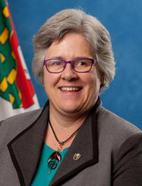Mahsi, Mr. Speaker. Mr. Speaker, I'd like to start by saying how very proud I am of my colleague Mr. Nadli. He has taken constructive steps to make himself a better man by starting on this healing journey, and we are all the better for it.
Mr. Speaker, women experience violence in greater numbers than men, but it's true that men also experience violence, and the effects of this violence include things like injuries, depression and other mental health issues, disease, addiction and even death. There are economic costs as well, mostly with loss in productivity but also the cost of treatment that amounts to billions of dollars a year.
Violence against women is a worldwide problem being addressed by the United Nations, national governments and territorial governments like ours. The recent report by the Chief Public Health Officer of Canada says, as you've heard, the NWT rate is nine times the national average, and believe it, Mr. Speaker, from December 2011 to December 2012 five women, five women, in the NWT were killed by intimate partners, and I'm going to name them because they should never be forgotten: Jenny Pingo of Tuktoyuktuk, Mary Laboucan of Fort Resolution, Carol Buggins and Linda Lafferty of Hay River and Yvonne Desjarlais of Yellowknife and most recently May Elanik of Aklavik.
Mr. Speaker, this is a problem everywhere in the Northwest Territories, and this is what's important to know in the context of this motion. Violence against women is not inevitable and it is preventable, and the key word here is prevention. Prevention involves reducing the number of new incidents of family violence with actions that address systemic issues. Why do men use violence against women and how do we stop them?
The Coalition Against Family Violence and the Department of Justice spent more than two years looking at programs that would help men to stop using violence. What they came up with is not an off-the-shelf program, but one which is culturally appropriate and community-based, and as my colleague Mr. Nadli said, the Public Health Agency of Canada has designated it an Aboriginal Best Practices Program. It is on the face of it the right program for this territory.
The department decided to pilot the program. It got off to a rough start because the non-profit contracted for delivery collapsed. The program really didn't start until two years ago and it was supposed to be a three-year pilot, but it's been incredibly successful in the time it has been going with more than 350 people who have attended some aspect or all of the program since it started and the anecdotal evidence is overwhelming in saying that it's effective.
Mr. Speaker, this program starts with asking men to take responsibility for their violent actions. They then go on to engage in individual and group therapy, they explore the circumstances and feelings that trigger a violent reaction such as their residential school experience and the feelings of anger and powerlessness that go with that memory. They begin a healing journey that addresses their unresolved trauma.
Some steps along the way include, as I said, defining abuse and taking responsibility for it, creating a relapse prevention plan, talking about the physical and psychological effects of abuse for women, and they also talk about how they can be part of the healing process for the women they've abused if the partners agree to participate. Many, many men have started their healing journey with the help of this program and more are ready to start. A New Day is set up and it's ready to continue and continuity is very important in this context.
I have no quarrel with evaluating the pilot. That is the right thing to do, but the prospect of shutting the program down before coming up with a replacement is completely unacceptable. Women have the right to be safe from violence, and that means intervention like family violence shelters, but it also means systemic addresses such as the A New Day program. This program needs to be extended for a year while the evaluation is not only finished but shared and plans are made for next steps. Mahsi. Mr. Speaker.
